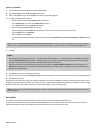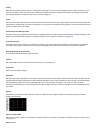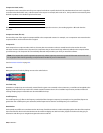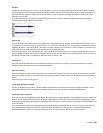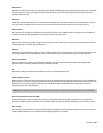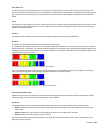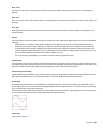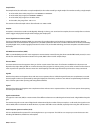Frequency Modulation (FM)
Frequency Modulation (FM) is a process by which the frequency (pitch) of a sound is varied over time. Subaudio frequency modulation
results in pitch-bending effects (vibrato). Frequency modulation within audio band frequencies (20 Hz - 20,000 Hz) creates many
different side-band frequencies that drastically alter the timbre of the sound.
Frequency Modulation (FM) Synthesis
This type of synthesis relies on the principles of Frequency Modulation. The FM Synthesis tool allows you to use frequency modulation
(FM) and additive synthesis to create complex sounds from simple waveforms.
In frequency modulation, the frequency of a waveform (the carrier) is modulated by the output of another waveform (the modulator) to
create a new waveform. If the frequency of the modulator is low, the carrier will be slowly detuned over time. However, if the frequency
of the modulator is high, the carrier will be modulated so quickly that many additional frequencies, or sidebands, are created.
In Sound Forge software, up to four waveforms (operators) can be used in a variety of configurations. Depending on the configuration,
an operator can be a carrier, a modulator, or a simple, unmodulated waveform.
Frequency Spectrum
The frequency spectrum of a signal refers to its range of frequencies. In audio, the audible frequency range is between 20 Hz and 20,000
Hz. The frequency spectrum sometimes refers to the distribution of these frequencies. For example, bass-heavy sounds have a large
frequency content in the low end (20 Hz - 200 Hz) of the spectrum.
Head-Related Transfer Function (HRTF)
Sounds are perceived differently depending on the direction the sound comes from. This occurs because of the echoes bouncing from
your shoulders and nose and the shape of your ears. A head-related transfer function contains the frequency and phase response
information required to make a sound appear to originate from a certain direction in 3-dimensional space.
Hertz (Hz)
The unit of measurement for frequency or cycles per second (CPS).
High-Pass Filter
A high-pass filter attenuates all frequencies below a cutoff frequency. It is usually used to remove low-frequency rumble from audio files.
Insertion Point
The insertion point (also referred to as the cursor position) is analogous to the cursor in a word processor. It is where markers or
commands may be inserted depending on the operation. The insertion point appears as a vertical flashing black line and can be moved
by clicking the left mouse button anywhere in the data window.
Inverse Telecine (IVTC)
Telecine is the process of converting 24 fps (cinema) source to 30 fps video (television) by adding pulldown fields. Inverse telecine, then,
is the process of converting 30 fps (television) video to 24 fps (cinema) by removing pulldown.
See also Pulldown on page 353; Telecine on page 357.
InterVoice Sound File Support
The InterVoice sound file format (.IVC), commonly used in telephony applications, is now supported and includes G.711 µ-Law and A-
Law, G.721 ADPCM (32 kb/s) and G.723 ADPCM (24 kb/s) data formats.
APPENDIX E | 349




